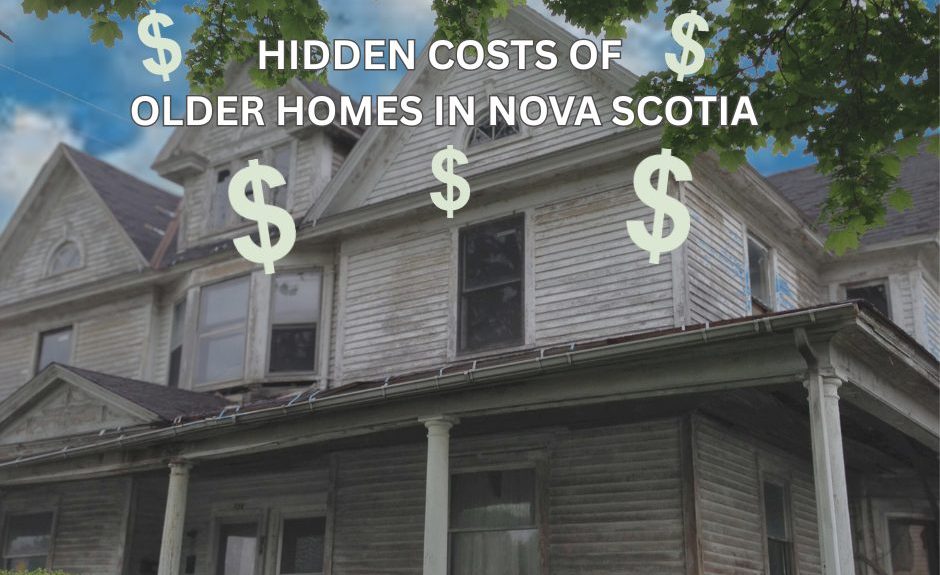The Hidden Costs of Older Homes in Nova Scotia: What Buyers Should Know
In a province like Nova Scotia, older homes are everywhere, and many come with a lower price tag that can seem too good to pass up. What’s not always obvious at first glance are the hidden costs that may come with those charming details and vintage finishes.
Whether you’re a first-time buyer, downsizing, or looking for character, here’s what you need to know before falling in love with an older home.
🔍 What to Watch For in Older Homes
1. Foundation Issues
Stone foundation basements or cellars can have moisture and uneven settling. These can lead to sloping floors and structural concerns. Cinder block foundations can have cracks and deterioration. Repairs can range from a few thousand to tens of thousands of dollars.
2. Unlevel Floors & Structural Settling
Sloped or bouncy floors might seem like quirks, but they could signal bigger problems with support beams or joists. Fixing them is rarely simple—or cheap.
3. Insulation (or Lack Thereof)
Homes built before 1960 often have little or no insulation, especially in walls or crawlspaces. Expect high heating bills and chilly drafts unless you invest in energy upgrades.
4. Outdated Electrical Systems
Knob-and-tube wiring, although less common now, still exists. Ungrounded outlets are common and many insurers won’t cover them. Codes have changed. Full rewiring can cost $20,000 or more.
5. Plumbing Pitfalls
Old galvanized pipes corrode over time, affecting water quality and pressure. And older drain systems may not be up to code. Fixing plumbing often means opening up walls or floors.
6. Septic Surprises
In rural areas, septic systems can be outdated or failing. A replacement could set you back $15,000–$30,000+. Always get an independent septic inspection.
7. Inefficient or Outdated Heating
Oil furnaces and wood stoves may no longer meet modern standards. Upgrading to electric or heat pumps is often smart—but not cheap. Also check for old oil tanks, especially underground.
8. Damp Basements & Water Damage
No weeping tile? Poor drainage? These can lead to mold and moisture damage. Not only is remediation costly, it can affect your health and resale value.
9. Asbestos and Lead
Many older homes contain asbestos in insulation, flooring, or plaster, and lead in paint. Professional removal is essential and expensive.
10. Windows & Doors
Drafty, single-pane windows and ill-fitting doors are common. Replacing them can improve efficiency but adds to your upfront investment.
11. Roof Trouble
Old shingles, poor ventilation, or damaged flashing can mean your roof needs replacing right away. Always check the attic for signs of water intrusion.
🛠 Buyer Tips: How to Be Prepared
-
Get a comprehensive inspection—choose an inspector who specializes in older homes.
-
Budget wisely: a low purchase price may just reflect high future repair costs.
-
Ask about insurance eligibility, especially for homes with old heat sources, old wiring, foundation and septic issues.
-
Don’t skip rural essentials: get water and septic inspections before committing.
https://www.novascotia.ca/nse/wastewater/on.site.sewage.disposal.asp
https://www.efficiencyns.ca/home
🏡 Final Thoughts
Older homes offer character, craftsmanship, and often great locations, but they can come with their fair share of surprises. The key is to go in with eyes wide open.
Thinking about buying an older home in Nova Scotia? Let’s talk. I’d be happy to connect you with experienced home inspectors, contractors, and resources to help you make a confident decision.
Peggy Jensen – Halifax REALTOR®
Email: peggy.jensen@century21.ca

 Facebook
Facebook
 X
X
 Pinterest
Pinterest
 Copy Link
Copy Link
